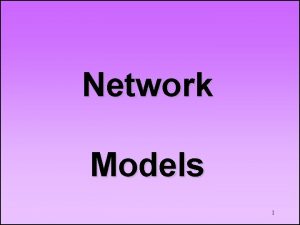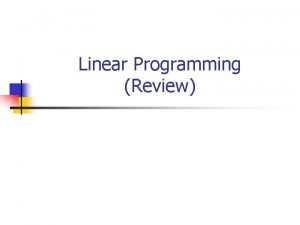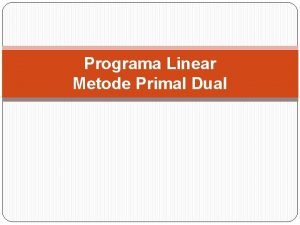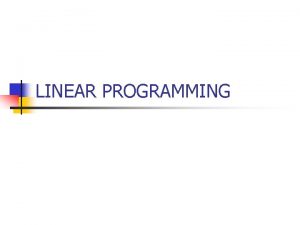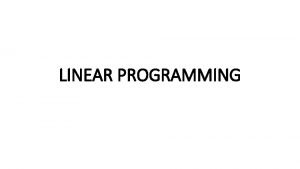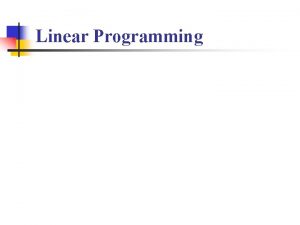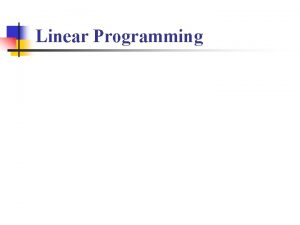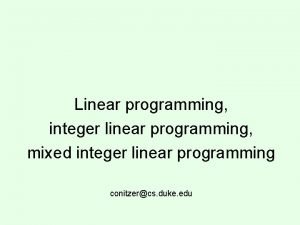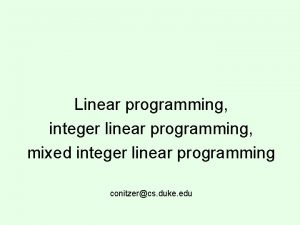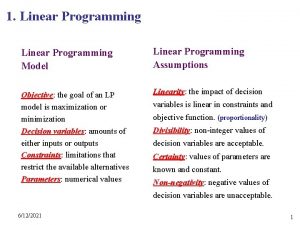Introduction to Linear Programming A Linear Programming model











- Slides: 11

Introduction to Linear Programming • A Linear Programming model seeks to maximize or minimize a linear function, subject to a set of linear constraints. • The linear model consists of the following components: – A set of decision variables. – An objective function. – A set of constraints. 1

Introduction to Linear Programming • The Importance of Linear Programming – Many real world problems lend themselves to linear programming modeling. – Many real world problems can be approximated by linear models. – There are well-known successful applications in: • Manufacturing • Marketing • Finance (investment) • Advertising • Agriculture 2

Introduction to Linear Programming • The Importance of Linear Programming – There are efficient solution techniques that solve linear programming models. – The output generated from linear programming packages provides useful “what if” analysis. 3

Introduction to Linear Programming • Assumptions of the linear programming model – The parameter values are known with certainty. – The objective function and constraints exhibit constant returns to scale. – There are no interactions between the decision variables (the additivity assumption). – The Continuity assumption: Variables can 4

The Galaxy Industries Production Problem – A Prototype Example • Galaxy manufactures two toy doll models: – Space Ray. – Zapper. • Resources are limited to – 1000 pounds of special plastic. – 40 hours of production time per week. 5

The Galaxy Industries Production Problem – A Prototype Example • Marketing requirement – Total production cannot exceed 700 dozens. – Number of dozens of Space Rays cannot • Technological inputof dozens of Zappers by exceed number – Space Rays 350. requires 2 pounds of plastic and more than 3 minutes of labor per dozen. – Zappers requires 1 pound of plastic and 4 minutes of labor per dozen. 6

The Galaxy Industries Production Problem – A Prototype Example • The current production plan calls for: – Producing as much as possible of the more profitable product, Space Ray ($8 profit per dozen). – Use resources left over to produce Zappers ($5 profit per dozen), while remaining within the marketing • The current production plan consists of: guidelines. Space Rays = 450 dozen 8(450) + 5(100) Zapper = 100 dozen Profit = $4100 per week 7

Management is seeking a production schedule that will increase the company’s profit. 8

A linear programming model can provide an insight and an intelligent solution to this proble 9

The Galaxy Linear Programming Model • Decisions variables: – X 1 = Weekly production level of Space Rays (in dozens) – X 2 = Weekly production level of Zappers (in dozens). • Objective Function: – Weekly profit, to be maximized 10

The Galaxy Linear Programming Model Max 8 X 1 + 5 X 2 (Weekly profit) subject to 2 X 1 + 1 X 2 £ 1000 (Plastic) 3 X 1 + 4 X 2 £ 2400 (Production Time) X 1 + X 2 £ 700 (Total production) X 1 - X 2 £ 350 (Mix) Xj> = 0, j = 1, 2 (Nonnegativity) 11
 Perbedaan linear programming dan integer programming
Perbedaan linear programming dan integer programming Linear vs integer programming
Linear vs integer programming Programing adalah
Programing adalah Network model linear programming
Network model linear programming Lp model formulation
Lp model formulation Characteristics of linear programming
Characteristics of linear programming Linear programming model formulation and graphical solution
Linear programming model formulation and graphical solution Linear programming model formulation and graphical solution
Linear programming model formulation and graphical solution Lp model formulation
Lp model formulation What is interactive communication model
What is interactive communication model Primal dual program linear
Primal dual program linear Greedy vs dynamic programming
Greedy vs dynamic programming



